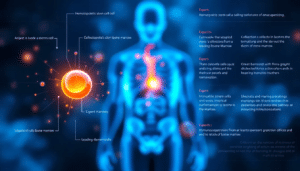The Battle Against Hair Loss

Losing your hair isn’t just a physical change—it’s an emotional rollercoaster. Every strand that falls feels like a hit to your confidence, leaving you feeling exposed and uncertain. Whether you’re noticing a thinning crown, a receding hairline, or full-on baldness, the struggle is undeniably real. But what if you could rewind the clock, using your own body to bring your hair back to life? Enter stem cells—tiny powerhouses of regeneration now at the forefront of hair restoration research.
Can You Use Stem Cell Therapy For As A Hair Loss Treatments?
Stem cell therapy is transforming the way we think about hair loss. Unlike traditional methods that only cover up the issue or slow it down, innovative methods like stem cell transplants aim to rejuvenate and revive your hair from the roots. By harnessing your body’s natural ability to regenerate, this approach doesn’t just stop hair loss—it might actually reverse it, offering hope to millions worldwide.
Hair loss isn’t a one-size-fits-all issue. What we mean is, it’s a complex process influenced by genetics, hormones, and/or time. For some, it’s a natural part of aging; for others, it’s driven by medical conditions or lifestyle choices. The most common type—male pattern baldness, or androgenetic alopecia—affects over half of men in the world by the age of 50.
Women face a different challenge. Hair loss in women typically shows up as a general thinning across the scalp rather than distinct bald patches. This can be caused by various factors, from hormonal imbalances to stress. Understanding the root cause of hair loss is crucial, as it guides the treatment approach. For instance, conditions like alopecia areata, an autoimmune disorder, require specialized care.
Understanding the Types of Hair Loss
To find the right treatment, you need to know the enemy you’re facing. Hair loss comes in many forms, each with its own characteristics and challenges.
Androgenetic Alopecia (Male and Female Pattern hair loss): The most common type, often passed down through families.
Alopecia Areata: Sudden, patchy hair loss triggered by the immune system. Innovative techniques involving human hair follicles, such as stem cell therapy, are being used to enhance hair growth and treat this condition.
Telogen Effluvium: Temporary shedding caused by stress, illness, or childbirth.
Anagen Effluvium: Rapid hair loss often due to chemotherapy.
Traction Alopecia: Hair loss from tension on the hair, usually from tight hairstyles.
Scarring Alopecia (Cicatricial Alopecia): Permanent loss due to inflammation that destroys hair follicles.
Postpartum Hair Loss: Hair shedding after childbirth due to hormonal shifts.
The Emotional Toll of Hair Loss
Hair loss isn’t just about losing hair—it’s can be as if you’re losing a part of your identity. In a world that equates a full head of hair with youth, vitality, and attractiveness, the emotional impact of baldness can weigh a person down. But, remember, it’s not just about how others see you; it’s about how you see yourself.
For many, the psychological effects of hair loss can lead to feelings of inadequacy, anxiety, and even depression. The constant worry about appearance can become a barrier to social interactions and professional opportunities. Research shows that people experiencing hair loss are more likely to struggle with social anxiety, low self-esteem, and a diminished quality of life.
What Are Stem Cells?
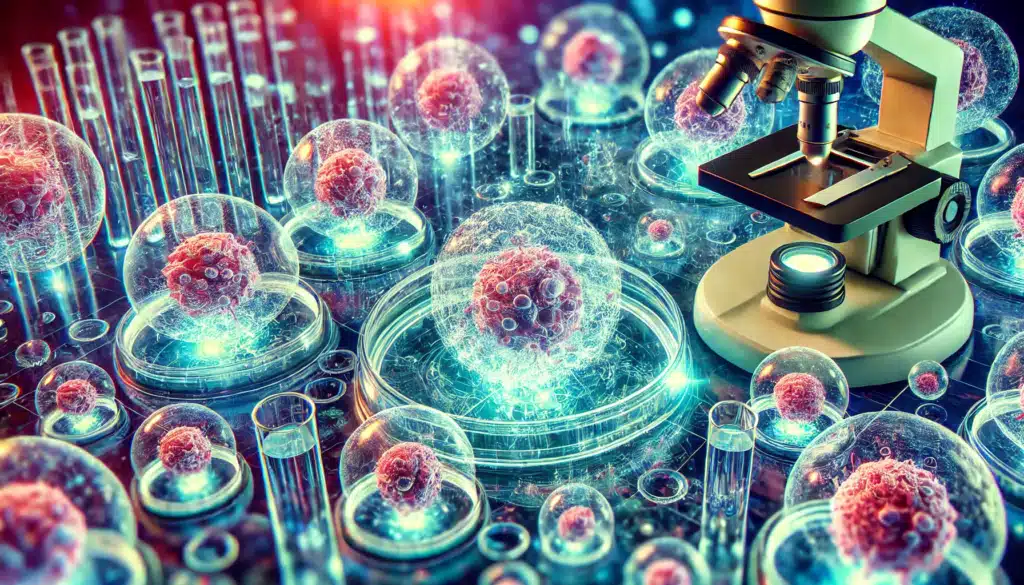
Stem cells are remarkable in their ability to develop into various cell types in the body. They act as a repair system, replenishing damaged or lost cells, making them invaluable in regenerative medicine. There are different types of stem cells, but mesenchymal stem cells (MSCs) and hair follicle stem cells are particularly relevant in the context of hair loss.
Exosomes, particularly those derived from stem cells, are being explored as innovative hair loss therapies. These stem cell-derived exosomes could stimulate hair growth by utilizing patients’ own biological resources.
In recent years, scientists have discovered that stem cells, specifically those derived from bone marrow and adipose tissue (adipose derived stem cells), could play a crucial role in regenerating hair follicles. These cells have the potential to transform into the specialized cells needed to create new hair, offering a groundbreaking approach to hair restoration.
The Role of Stem Cells in the Body
Stem cells serve two main purposes in the body: to maintain and repair tissues. Mesenchymal stem cells are especially versatile, capable of differentiating into bone, cartilage, and fat cells.
In hair restoration, these cells hold the potential to revive dormant or damaged hair follicles. When injected into areas of hair loss, they may stimulate growth by promoting the health and activity of existing follicles—or even create new ones. This regenerative ability positions stem cells as a promising frontier in the fight against hair loss.
How Stem Cells Could Address Hair Loss
Stem cells serve two main purposes in the body: maintaining and repairing tissues. Mesenchymal stem cells are especially versatile, capable of differentiating into bone, cartilage, and fat cells.
In hair restoration, these cells hold the potential to revive dormant or damaged hair follicles. When injected into areas of hair loss, they may stimulate growth by promoting the health and activity of existing follicles—or even create new ones. This regenerative ability positions stem cells as a promising frontier in the fight against hair loss.
The Science of Stem Cells and Hair Regrowth
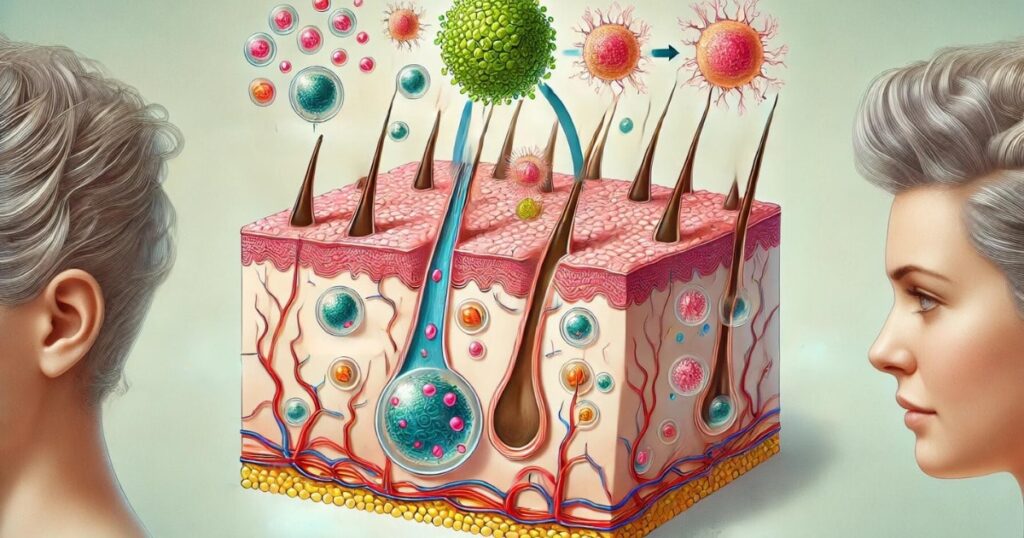
The science behind stem cells and their potential to regrow hair is both fascinating and complex. At the heart of this process is the interaction between stem cells and hair follicles. Hair follicles are responsible for producing hair, and their health is crucial for maintaining a full head of hair. However, over time or due to genetic factors, these follicles can shrink, become dormant, or die off completely.
Early research shows that stem cells could be particularly effective in cases of androgenetic alopecia, where hair follicles shrink and lose their ability to regenerate. By introducing new, healthy cells into the scalp, stem cell therapy may help to reverse this process, leading to thicker, fuller hair over time. This possibility is what makes stem cell therapy so exciting in the field of hair restoration.
How Stem Cells Interact with Hair Follicles
Stem cell treatment for hair, particularly those derived from adipose tissue or bone marrow, has shown great promise in revitalizing hair follicles. When these stem cells are introduced to the scalp, they can migrate to areas of thinning or dormant hair follicles. Once there, they can help repair and stimulate these follicles, potentially bringing them back to a healthy state where they can produce hair again.
The interaction is primarily driven by growth factors secreted by stem cells. These factors promote cellular activity within the hair follicles, encouraging them to enter the growth phase of the hair cycle. By boosting the health of existing follicles and possibly encouraging the formation of new ones, stem cells offer a novel approach to combating hair loss.
Understanding Hair Follicle Biology
Hair follicles are intricate, tiny structures embedded in the skin. Each follicle is capable of producing one strand of hair and cycles through phases of growth (anagen), rest (telogen), and shedding (catagen). In healthy individuals, this cycle is well-regulated, resulting in consistent hair growth.
However, in cases of hair loss, this cycle is disrupted. Factors like hormonal changes, aging, and stress can cause follicles to enter the resting phase prematurely, leading to thinning hair and eventual baldness. Stem cell therapy holds the potential to reset this cycle, pushing follicles back into the growth phase and restoring hair density.
The Mechanisms of Stem Cell Therapy for Hair Regrowth
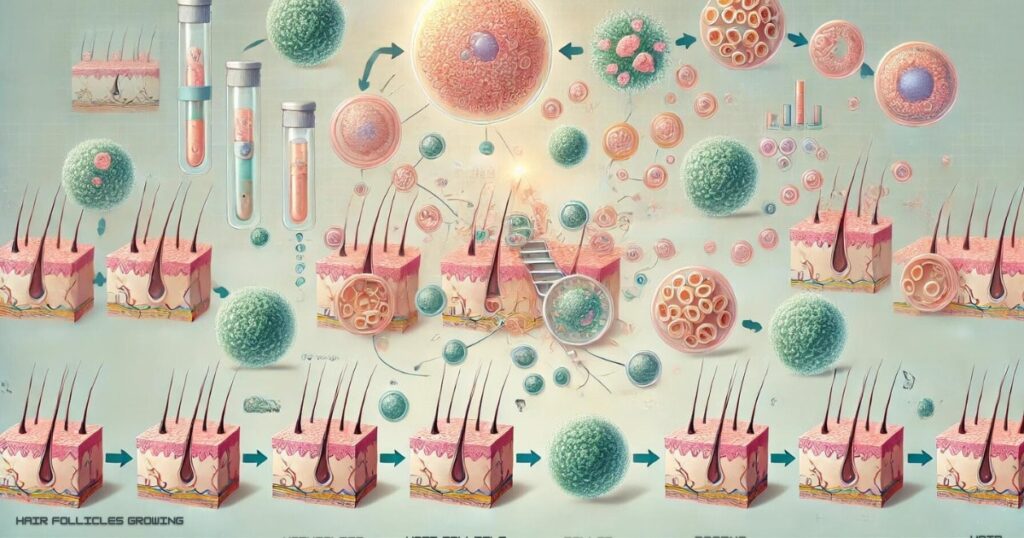
Stem cell therapy for hair regrowth works through several key mechanisms. One is the anti-inflammatory properties of stem cells, which can reduce the inflammation that often accompanies hair loss conditions like alopecia areata. By calming inflammation, stem cells create a more favorable environment for hair follicles to thrive.
Additionally, stem cells can enhance blood flow to the scalp, ensuring that hair follicles receive the oxygen and nutrients they need to grow. This increased circulation, combined with the regenerative properties of stem cells, can lead to noticeable improvements in hair thickness and overall scalp health.
Current Research and Findings: A Glimpse Into Our Future
The research into stem cells for hair loss is still in its early stages, but the findings so far are promising. Several studies have demonstrated that stem cell therapy can stimulate hair growth in both men and women with various types of hair loss. The process of stem cell hair treatment involves the extraction of hair follicles, culturing them in a lab, and then injecting them back into the scalp to stimulate growth. In some cases, patients have reported significant improvements in hair density and quality after undergoing stem cell treatment.
Breakthrough Studies: Promising Results
One of the most exciting areas of research involves adipose-derived stem cells. These cells, harvested from a patient’s own fat tissue, have shown the ability to induce hair regrowth by reviving dormant follicles. A study conducted in 2020 revealed that patients treated with adipose-derived stem cells experienced a significant increase in hair density after just a few sessions.
Another study focused on mesenchymal stem cells, which are renowned for their regenerative properties. The findings suggested that these cells could prolong the growth phase of hair follicles, resulting in thicker, stronger hair. This has the potential to be a game-changer for those battling hair loss.
Stem Cell Therapy: From Theory to Practice
While the science behind stem cell therapy is compelling, what does the actual treatment process look like? Transitioning from theory to practice involves several steps, from initial consultation to post-treatment care. For those considering this innovative approach, understanding the procedure can help set realistic expectations.
The Stem Cell Hair Restoration Procedure
The process of stem cell hair restoration begins with a thorough consultation. During this session, a specialist will assess your hair loss pattern, discuss your medical history, and determine if you’re a suitable candidate for the treatment. If you proceed, the next step involves harvesting stem cells, typically from your own body.
The most common way we can source stem cells is through adipose tissue, which is collected through a minimally invasive liposuction procedure. Once harvested, the stem cells are processed and prepared for injection into the scalp. The procedure is relatively quick, often completed in a single session, with minimal downtime.
After the stem cells are injected, they begin their work of repairing and stimulating the hair follicles. Over the following weeks and months, patients may start to notice improvements in hair thickness and density. Because this treatment utilizes your own cells, the risk of rejection or adverse reactions is low, making it a safe option for many.
Consultation and Suitability Assessment
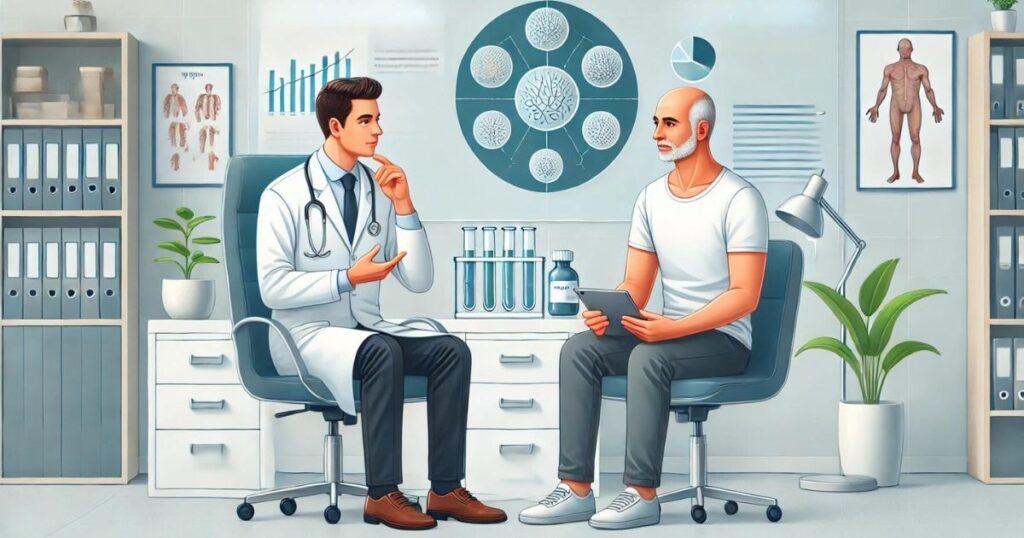
The process of stem cell hair restoration begins with a thorough consultation. During this session, a specialist will assess the extent of hair loss, discuss the patient’s medical history, and determine if stem cell therapy is a suitable option.
Once a patient is deemed as suitable, the next step could be the extraction of stem cells. This is typically done using a minimally invasive technique, such as liposuction, to harvest adipose tissue from the patient. The harvested tissue is then processed to isolate the stem cells, which are prepared for injection into the scalp.
After the stem cells are ready, they are carefully injected into the area where hair loss on the scalp is noticeable. This process is done using fine needles to ensure precision and minimize discomfort. The entire procedure typically takes a few hours, depending on the extent of the treatment area. Patients can usually return home the same day, with minimal downtime.
***
However, in the case that your stem cells specialist can’t go through with extracting autologous stem cells, the next stem may actually be injecting the donor cells, typically derived from umbilical core blood or placenta blood.
Post-Treatment Care and Expectations
Post-treatment care is essential to maximize the results of stem cell therapy. Patients are usually advised to avoid strenuous activities for a few days and to follow specific guidelines provided by their healthcare provider. It’s important to protect the treated area from excessive sun exposure and to avoid harsh hair treatments for a period of time.
Following the procedure, patients may experience mild swelling or redness at the injection sites, but this typically subsides within a few days. The most crucial part of recovery is patience, as visible results can take several months to manifest. Regular follow-up appointments allow the specialist to monitor progress and make any necessary adjustments to the treatment plan.
Timeline for Visible Hair Regrowth
Hair regrowth is a gradual process, with most patients beginning to see new hair growth within three to six months post-treatment. Full results may take up to a year, as the hair follicles slowly regenerate and produce new hair. The regrowth is often subtle at first, with hair density gradually increasing over time.
Evaluating the Benefits and Risks
Stem cell therapy for hair loss offers numerous benefits, but like any medical treatment, it also comes with potential risks. Understanding both the advantages and possible drawbacks is essential for anyone considering this approach.
Advantages of Stem Cell Therapy for Hair Loss
The process of stem cell hair restoration begins with a thorough consultation. During this session, a specialist will assess the extent of hair loss, discuss the patient’s medical history, and determine if stem cell therapy is a suitable option. Not everyone is an ideal candidate, so this step is crucial in ensuring the best possible outcome.
Once deemed suitable, the next step is the extraction of stem cells. This is typically done using a minimally invasive technique, such as liposuction, to harvest adipose tissue from the patient. The harvested tissue is then processed to isolate the stem cells, which are prepared for injection into the scalp.
Potential for Long-Term Hair Regrowth
Stem cell therapy’s ability to promote long-term hair regrowth stems from its regenerative nature. By revitalizing existing hair follicles and potentially generating new ones, the treatment offers a solution that could last for years. Many patients find that the initial results continue to improve over time as their hair becomes thicker and healthier.
Risks and Considerations
Despite its many benefits, stem cell therapy is not without risks. As with any medical procedure, there is a possibility of side effects, although they are generally mild. These can include temporary swelling, redness, or discomfort at the injection sites. More serious complications are rare but can occur if the procedure is not performed by a qualified specialist.
The most common side effects of stem cell therapy are mild and temporary. Patients might experience some redness or swelling at the injection sites, which typically resolves within a few days. Infection is a rare but possible risk, emphasizing the importance of choosing a reputable clinic for the procedure.
Who Might Not Be a Suitable Candidate?
Stem cell therapy may not be suitable for everyone. Individuals with certain medical conditions, such as active infections or autoimmune disorders, may be advised against the treatment. Additionally, those with extensive baldness may not see significant results, as the therapy relies on the presence of some existing hair follicles to be effective.
Real-Life Results and Testimonials

One of the most compelling aspects of stem cell therapy is its impact on patients’ emotional well-being. For many, the treatment marks the end of a long battle with hair loss and the beginning of a renewed sense of self. Testimonials often reflect a deep appreciation for the natural, subtle results that allow individuals to feel like themselves again.
Hearing from others who have undergone stem cell therapy can provide valuable insights into what to expect. Real-life testimonials and before-and-after photos offer a glimpse into the potential outcomes and the transformative effects of the treatment.
Many patients who have undergone stem cell therapy report positive outcomes, with noticeable improvements in hair density and quality. These success stories often highlight the treatment’s ability to restore not just hair, but also confidence. Patients describe regaining their self-esteem and feeling more comfortable in social and professional settings.
To see our patient testimonials about how stem cells changed their life, click HERE.
Expert Opinions and Analysis
Experts in the field of hair restoration have weighed in on the potential of stem cell therapy. Their insights help to contextualize the treatment within the broader landscape of hair loss solutions, like hair transplants, laser caps, and medications, which not only allow us to see how it works with other treatments, but also how it can accelerate or enhance the results with other treatments. By comparing traditional hair transplant techniques with emerging methods like stem cell hair transplants, we can better understand the evolving landscape of hair loss treatments and their postoperative results, potential side effects, and comparative advantages.
What Leading Experts Are Saying
Leading experts in dermatology and hair restoration are increasingly recognizing the potential of stem cell therapy. Many view it as a promising option for those who have not responded well to traditional treatments. Experts emphasize the importance of ongoing research to fully understand the long-term effects and refine the techniques used.
While the consensus is generally positive, experts caution that stem cell therapy is not a one-size-fits-all solution. Its effectiveness can vary depending on the individual’s specific type of hair loss and the expertise of the practitioner. However, for many, it represents a significant advancement in the treatment of hair loss.
The Future of Stem Cells in Hair Restoration
The future of hair restoration is looking brighter with ongoing advancements in stem cell research. Emerging innovations and upcoming clinical trials are set to further refine the techniques and broaden the possibilities for personalized treatments.
Innovations in stem cell therapy are continually emerging, with researchers exploring new ways to enhance the treatment’s effectiveness. One such innovation involves combining stem cell therapy with other regenerative techniques, such as platelet-rich plasma (PRP), to boost hair regrowth.
Is Stem Cell Therapy Right for You?
Deciding whether stem cell therapy is the right choice for you involves weighing the pros and cons, comparing it to traditional treatments, and consulting with a qualified specialist. This section will guide you through the decision-making process, helping you determine if this innovative treatment is the best fit for your needs.
Comparing Traditional Treatments with Stem Cells
When considering hair loss treatments, it’s essential to compare the potential outcomes, risks, and costs of traditional methods versus stem cell therapy. Traditional treatments, like minoxidil or hair transplants, can be effective but may not offer the same regenerative benefits as stem cells. On the other hand, stem cell therapy, while promising, is still relatively new and may not be as widely accessible.
Making an Informed Decision: Consulting with Professionals
The best way to determine if stem cell therapy is right for you is by consulting with a specialist who can assess your specific situation. A professional evaluation will consider factors like the extent of hair loss, your overall health, and your expectations for the treatment. By gathering all the necessary information, you can make a well-informed decision about whether to pursue this cutting-edge therapy.
Conclusion: The Promise and Potential of Stem Cells for Hair Loss
Stem cell therapy represents a new frontier in the fight against hair loss, offering hope to those who have struggled with thinning hair or baldness. While the science is still evolving, the potential for long-term hair regrowth and the minimally invasive nature of the treatment make it an exciting option for many.
Key Takeaways
Stem cells have the potential to revolutionize hair restoration by addressing the root causes of hair loss. Through their regenerative properties, they can revive dormant hair follicles, stimulate new growth, and potentially provide a long-term solution for those seeking to restore their hair.
Stem cells have the potential to revolutionize hair restoration by addressing the root causes of hair loss. Through their regenerative properties, they can revive dormant hair follicles, stimulate new growth, and potentially provide a long-term solution for those seeking to restore their hair.
Stem cells have the potential to revolutionize hair restoration by addressing the root causes of hair loss. Through their regenerative properties, they can revive dormant hair follicles, stimulate new growth, and potentially provide a long-term solution for those seeking to restore their hair.
Book Your Consultation Today!
If you’re considering stem cell therapy for hair restoration, the first step is to book a consultation with our experts at Stem Cells LA. Located in the heart of Redondo Beach, Los Angeles, our clinic is dedicated to providing personalized care and the latest advancements in regenerative medicine.
Visit Us at Our Redondo Beach Location
Our state-of-the-art facility in Redondo Beach offers a welcoming environment where you can explore the possibilities of stem cell therapy. Whether you’re local to Los Angeles or traveling from out of town, our convenient location makes it easy for you to receive the care you need.
Address: Stem Cells LA
1970 S Prospect Ave # 2,
Redondo Beach, CA 90277
Contact Us
We understand that every patient’s journey is unique, and our team is here to guide you every step of the way. To learn more about our services or to schedule your consultation, please reach out to us:
Phone: (310) 281-6160
Book Online: stemcells.la
Take the first step towards reclaiming your hair and confidence. Contact Stem Cells LA today to schedule your consultation and explore how stem cell therapy can help you achieve your hair restoration goals.

